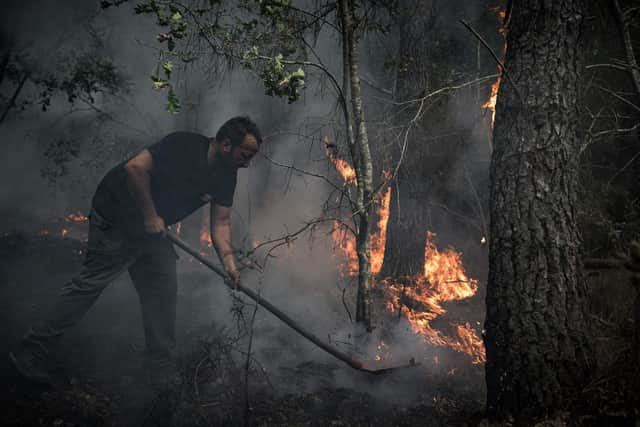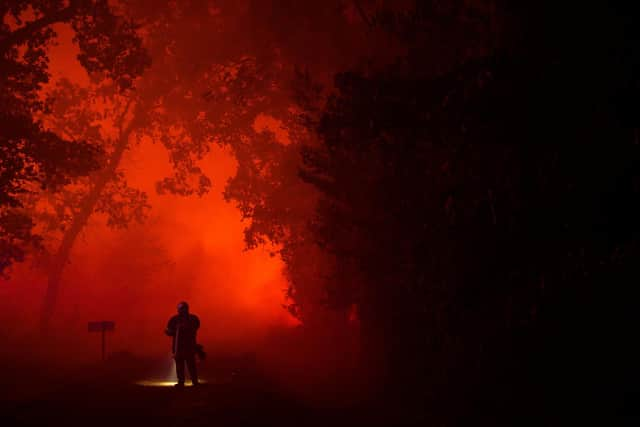Climate change: Heatwaves, droughts and floods bring grim taster of future as COP27 looms
Experts fear the pattern is set to become the new normal as climate change wreaks increasing havoc on the planet.
Europe has in 2022 had its hottest summer and highest August temperatures ever known, bringing vicious wildfires, severe droughts and extra deaths.
Advertisement
Hide AdAdvertisement
Hide AdMassive blazes raged across the land in a dozen countries across the European Union, destroying homes, businesses and nature and forcing thousands of people to flee.
There were nearly 2,000 fires across the region by July, more than four times the 15-year average, destroying an area covering 660,000 hectares – more than double the size of Luxembourg – the highest amount of land ever burned in the region by this stage in the summer.
And the season is not over yet, with huge fires being tackled in the Gironde region of France and Andalucia in Spain this week.
Even at home the weather has been unusually dry and blisteringly hot.
This summer was England’s joint-hottest ever and the fourth-hottest for the UK overall.


In July, a red ‘danger to life’ alert was issued over searing heat, indicating a national emergency, with thermometers reaching 40C for the first time in history.
People in the hottest places were advised to stay at home and not travel unless they had to, while there was major disruption to transport and other services.
The unprecedented heatwave saw temperature records smashed in Scotland, Wales and England, reaching new highs of 34.8C, at Charterhall in the Scottish Borders, 37.1C at Hawarden Airport in Flintshire and 40.3C at Coningsby in Lincolnshire.
Advertisement
Hide AdAdvertisement
Hide AdOrdinarily, when heat records are broken during hot spells, they do so in only a few places and by fractional degrees.


But the UK’s previous highs were exceeded in multiple locations and by large margins.
Scientists said the extreme heat would have been impossible without a boost from man-made climate change.
The prolonged hot spell compounded already arid conditions after a particularly dry start to the year.
In Scotland water extractions were suspended at rivers in Fife, Aberdeenshire, East Lothian and the Borders because levels had fallen so low.
At the same time official droughts were declared in regions of southern England, with hosepipe bans put in place to conserve water supplies.
Farmers have warned there could be shortages of some food crops this winter as a result of the challenging growing conditions.
And the story has been similar in many other locations across the world.
Advertisement
Hide AdAdvertisement
Hide AdAccording to the latest climate bulletin from Copernicus, an arm of the European Union’s space programme, the global average temperature for August took joint third place in the list of highest ever recorded.
Central and eastern China were hotter than normal for all of the past three months, while North America also experienced one of its warmest summers.
Conditions were drier than usual in central North and South America and across central Asia as well.
Other regions, however, have been exceptionally wet.
Increased rainfall has hit south Asia – particularly Pakistan, where record rainfall has been causing catastrophic flooding that has already killed more than 1,400 people and left millions of others homeless.
The country was lashed with more than three times the usual volume of rain for the time of year, making it the wettest August since 1961.
New analysis by a team of leading international climate scientists from the World Weather Attribution group has blamed industrial activities and the use of fossil fuels for the intense rainfall.
“What we saw in Pakistan is exactly what climate projections have been predicting for years,” said Friederike Otto, from the Grantham Institute – Climate Change and Environment at Imperial College London.
“It’s also in line with historical records showing that heavy rainfall has dramatically increased in the region since humans started emitting large amounts of greenhouse gases into the atmosphere.
Advertisement
Hide AdAdvertisement
Hide Ad“And our own analysis also shows clearly that further warming will make these heavy rainfall episodes even more intense.
“So while it is hard to put a precise figure to the contribution of climate change, the fingerprints of global warming are evident.”
Much of Scandinavia, areas of central and south-eastern Europe, Greece and western Turkey have also been wetter than average this summer.
The most recent assessment report from the Intergovernmental Panel on Climate Change (IPCC), first published late last year, concluded the occurrence of extreme events is unprecedented in the observed record and will increase as the planet heats up.
It states: “Human-induced climate change is already affecting many weather and climate extremes in every region across the globe.
“Evidence of observed changes in extremes such as heatwaves, heavy precipitation, droughts and tropical cyclones, and, in particular, their attribution to human influence, has strengthened.”
Each decade since the 1980s has been warmer than the previous one, and this pattern is expected to continue.
Average global temperatures could reach as much as 4C higher than in our horse and cart days, perhaps more.
Advertisement
Hide AdAdvertisement
Hide AdThe seven warmest years have all been since 2015, with 2016 and 2020 tied as the hottest.
Last year was also the seventh consecutive year when the global temperature has been more than 1C above pre-industrial level – edging closer to the 1.5C warming limit laid out under the 2015 Paris Agreement on climate change
And it looks like the hot trend has no sign of abating as September unfolds.
As well as more frequent extreme weather, unnaturally high concentrations of greenhouse gasses in the atmosphere are causing a range of other impacts, including sea level rise and ocean acidification.
Researchers have warned that multiple tipping points – thresholds from where there is no going back – could be triggered if global temperature rises more than 1.5C above pre-industrial levels, but there are significant risks at even the current levels of heating, around 1.2C since the 1850s.
Scientists at the University of Exeter say the planet is already in the danger zone for five climate tipping points – melting of the Greenland and West Antarctic ice sheets, widespread abrupt permafrost thaw, collapse of convection in the Labrador Sea, and massive die-off of tropical coral reefs.
And from then on, other impacts will only increase – and accelerate.
If all this sounds apocalyptic, it is.
The problems facing the planet and our species cannot be overstated. Climate change has been described as the greatest existential threat to humankind.
Advertisement
Hide AdAdvertisement
Hide AdThe last time earth was hotter was at least 125,000 years ago, while atmospheric carbon dioxide is at its highest level in two million years or longer.
The planet’s temperature has shot up faster in the past 50 years than in any comparable period, while the oceans are warming at a rate not seen in at least 11,000 years.
The world’s top climate scientists have agreed 2C of heating will spark catastrophic and irreversible climate destruction, leading to mass extinctions, altered seasons and threatening the survival of millions of people.
Hence the aim is to keep temperature rise below that deadly figure – ideally no more than 1.5C.
But there’s more bad news.
The World Meteorological Organisation has warned there is a 50:50 chance of the annual average global temperature temporarily reaching 1.5C for at least one of the next five years – and the likelihood is increasing with time.
The United Nations body said there is a 93 per cent likelihood of at least one year between now and 2026 becoming the warmest on record, knocking 2016 from the top ranking.
It’s now ten months since Scotland hosted the UN climate summit COP26, which culminated in the historic Glasgow Pact – signed by nearly 200 global leaders, agreeing to ramp up emissions reductions and to phase down coal power.
Prior to the conference, experts predicted the world was on track to massively overshoot 2C – perhaps reaching 4C or more.
Advertisement
Hide AdAdvertisement
Hide AdSince Glasgow, taking mitigation pledges and 2030 targets into consideration, estimates have been revised down to around 2.4C.
So, as we head towards COP27, being held in Egypt in November, there is a dauntingly massive mountain to climb.
The main objective of the meeting is to turn pledges into action, emphasising the need to “move from negotiations to implementation through specific, measurable, impactful initiatives to be delivered and implemented on the ground”.
The world still has a chance to do this by taking immediate and drastic action to slash emissions.
But, as we’ve been warned, it is now or never.
Comments
Want to join the conversation? Please or to comment on this article.
